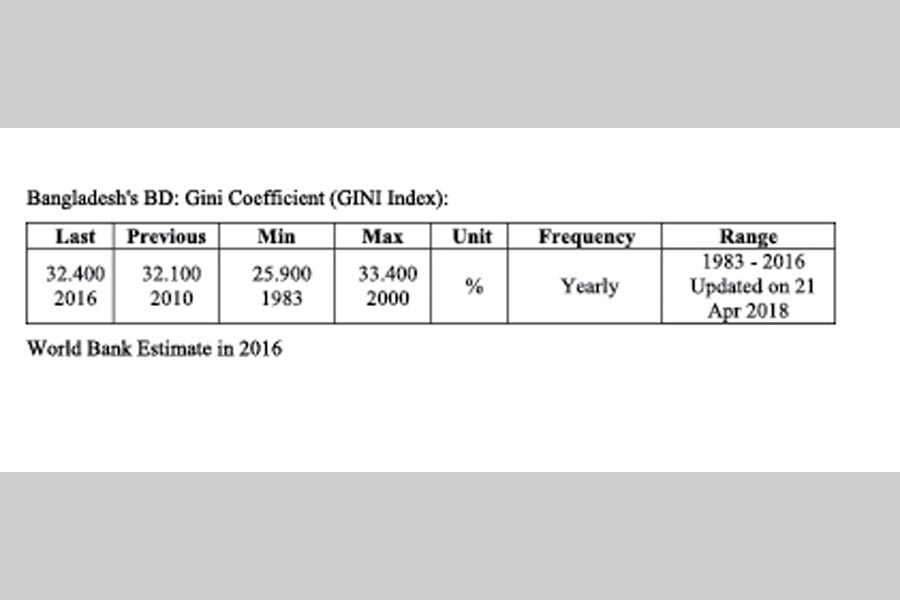Income inequality is extreme concentration of wealth or income in the hands of a small section of the population. It is often described as the gap between the richest and the rest of the community. The Urban Institute of the United States in an analysis based on 53 years (1963-2016) of economic data reflected that the poorest have become poorer while the richest much richer during this time. According to the report, the poorest 10 per cent of Americans moved from zero assets to $1,000 in debt. Families at the middle income level more than doubled their prior average wealth, families in the top 10 per cent obtained more than five times their prior wealth, and families in the top 1 per cent amassed more than seven times their prior wealth. According to a 2017 Federal Reserve report, the richest 1 per cent of the U.S. population possessed 38.6 per cent of the nation's wealth in 2016,
Bangladesh has remained a country with substantial income inequality with all its manifestations even 48 years after independence. A small section of the society enjoys most of the country's wealth depriving the larger sections. Income share held by the highest 10 per cent increased from 21 per cent in 1984 to 27 per cent in 2010. Income share held by the lowest 10 per cent declined from 4.13 per cent to 3.99 per cent.
Amidst many positive achievements, an important area of concern for Bangladesh economy is the rise in inequality in income distribution. After all, the dream of economic emancipation through alleviation of economic inequality was one of the driving forces of our liberation war. Regrettably, there has been an increase in the degree of inequality in income distribution from the mid-1980s. As per the latest Household Income and Expenditure Survey (HIES) of Bangladesh Bureau of Statistics (BBS), the country's Gini coefficient, which is the economic measure of equality, stood at 0.482 in 2016, up from 0.458 in 2010, in a worrying development. Historically Gini stood at 33.12 in 2010 from 33.22 in 2005. The Gini coefficient was 25.88 in 1984 and went up to 33.46 in 1996.
At the time of independence, over 90 per cent of Bangladeshis were villagers, a share that has now come down to nearly 70 per cent. Historical experience suggests that if our economy grows faster, more and more people would flock to the cities. So, Dhaka is now home to 10 per cent of the population, up from 2 per cent four decades back. Lack of decentralisation is also causing a growing spatial inequality in income earnings. People living in Dhaka and Chottogram are earning way more than those living elsewhere.
Bangladesh had a plan to halve the rich-poor gap by 2015 as part of the Millennium Development Goals. It's the one of the MDGs that was overachieved and before time. Macroeconomic and social indicators show that Bangladesh has been better off as an independent nation though it is far behind in achieving its primary goal of alleviating economic and political inequality. Macroeconomic growth contributed to higher national income, but growing income inequality needs to be addressed. Geographically centralised industrialisation has contributed to a higher flow of domestic migration, and the added workforce helped the national economy set the trend of growth over the past years.
The trend raises questions about the quality of Bangladesh's much-lauded GDP growth. "The economic growth in recent years has been far from inclusive," said Selim Raihan, executive director of the South Asian Network on Economic Modelling (SANEM). Official statistics show that the country experienced accelerated GDP growth rate since 2013; the GDP growth in recent years has been the highest in the country's history. "However, inequality rose significantly during this period -- this is a big concern," Selim Raihan added. One reason is the disconnect among economic growth, wage growth and job creation. Though figures show that GDP growth has accelerated in recent years, job growth has slowed and real wage growth has been sluggish. The high GDP growth over the past few years has been unable create sufficient jobs. In other words, the country is witnessing a phase of jobless growth as the poor people are not getting enough scope for productive income generating employment activities.
This has resulted in slow progress in poverty reduction and rising inequality. The public expenditure on education and health as a share of GDP is very low and has declined in recent years. Such low expenditure does not help improve productivity of workers and is not consistent with the effort to reduce poverty and inequality. There is also an increasing inequality of opportunities, particularly to access healthcare, education, financial services and social protection. Nor are the poor in a position to access privileges that the government gives to particular businesses and interest groups in the form of bailouts, loan rescheduling, tax exemptions, subsidies, licences and so on. The social protection programmes are too inadequate to reduce poverty and regional disparity. Expenditure programmes that are targeted to the poor suffer from serious leakages.
A stronger focus keeping these in mind is crucial for devising plans for inequality reduction. Inequality is not an inevitable consequence of economic growth. In fact, long-term growth and social stability are the two important factors to make space for social and economic equality.
Dr. Muhammad Abdul Mazid is former Secretary to GoB and Chairman, NBR. [email protected]


